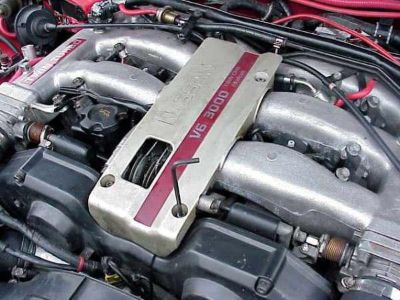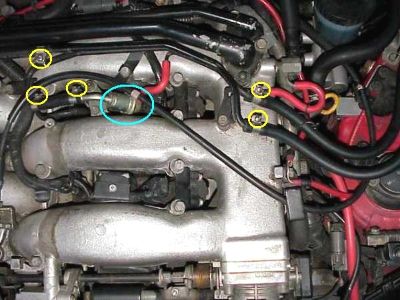
Cold weather will often create the smell of gasoline inside the cabin. Ninety percent of the time the clamps on the fuel lines have worked themselves loose. The rubber fuel injection lines get harder in the winter, and this allows fuel to leak out around any loose clamps. Often when the engine warms up, the hoses get soft again and stop leaking, for awhile. If the fuel injection line is original, then the lines themselves should be replaced. Driving around with the smell of gas under the hood is risky, and has led to many Z engine fires.
Note, there is a big difference between fuel lines in carbureted engines (low pressure) and fuel INJECTION line used in Z's (high pressure), the latter around 40 psi, depending on the throttle. Don't use plain ol' gas lines in a Z or they will rupture, spraying gas everywhere under the hood, causing an engine fire and the end of any love affair that may have existed between car and driver.
Tightening the fuel clamps more than once a year is a good idea, but the start of winter is when peeps usually notice the smell. One short "Bastard Piece of Hose from Hell" between the front of the fuel rails can be hard to access. The rest of the clamps are easy to see. Even the two clamps connecting the front of the fuel rail are easy to tighten, once the clamps are turned and facing in the right direction. My first plenum pull was a result of a leak in this Bastard Piece of Hose from Hell.
 Go for the most obvious first :c) Tighten the four clamps around the fuel filter. Check and make sure the fuel filter is facing the right direction, a fairly common installation mistake. Go for the most obvious first :c) Tighten the four clamps around the fuel filter. Check and make sure the fuel filter is facing the right direction, a fairly common installation mistake.
The flat side of the fuel filter is facing the front of the car. There are a few more clamps not shown connected to the hard lines in the bottom right corner, further upstream. In my experience, these clamps rarely leak, probably because they are further away from the heat of the engine.
 Use a 5mm Allen wrench to remove the four screws that attach the throttle cover to the upper plenum. Use a 5mm Allen wrench to remove the four screws that attach the throttle cover to the upper plenum.
 Blue circle is around the fuel pressure regulator. Five fuel clamps that should be checked are circled in yellow. Blue circle is around the fuel pressure regulator. Five fuel clamps that should be checked are circled in yellow.
The left side of my engine bay in the above pic may look a little different than yours because of my earthing kit and PRVR bypass. Don't sweat it.
 There are three clamps around the fuel damper on the right side of the plenum. The red arrow is on a screwdriver shaft that is sitting on top of the third screw. There are three clamps around the fuel damper on the right side of the plenum. The red arrow is on a screwdriver shaft that is sitting on top of the third screw.
There is a short piece of hose connecting the front of the fuel rails that is the hardest to access. Unless the clamps are facing in the right direction, they may not be able to be tightened without removing the upper plenum. However, if they are loose to begin with, then they can sometimes be rotated into position and tightened.
This hose is hard to see. Here is a pic of the hose with the upper plenum pulled, between the green arrows. I learned about this Bastard Piece of Hose from Hell when I took my Z to a dealer (first mistake) and told them I could smell a fuel leak. They returned the car to me and said they couldn't find it. I found it myself, and had friends help me pull the plenum to replace the hose, along with a new set of fuel injectors.
Peeps have replaced the hose without pulling the plenum, but it takes some nimble fingers and creative tools. Here is a post by John Zack from TT.net on how to do just that.
The screws on my fuel rail hose are already lined up so that I can tighten them with the throttle cover off.
 R fuel rail hose screw, front of engine, above the timing belt covers, underneath the throttle body linkage and cables R fuel rail hose screw, front of engine, above the timing belt covers, underneath the throttle body linkage and cables
 Turning R fuel rail hose screw with long, skinny Phillips screwdriver Turning R fuel rail hose screw with long, skinny Phillips screwdriver
 L fuel rail hose screw L fuel rail hose screw
 Turning L fuel rail hose screw with long, skinny screwdriver Turning L fuel rail hose screw with long, skinny screwdriver
If the screws on the clamps at the ends of this Bastard Piece of Hose from Hell are not accessible, try hard to spin the clamps to get to the screws. This is a common spot for a fuel leak.
| 


